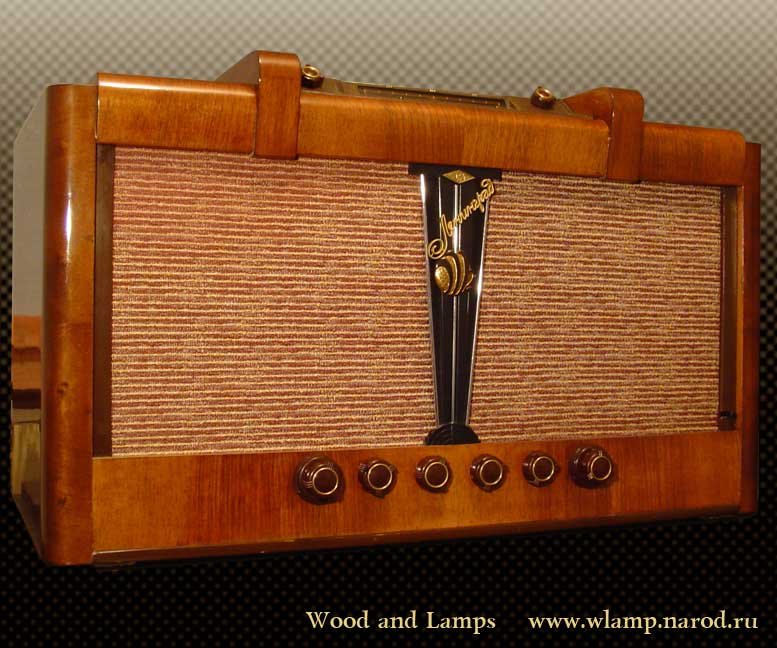It's a pity that I haven't been on the forum for a while and missed the discussion about that wonderful television, it's time to catch up:

The Leningrad-T2 television was introduced in 1949 as a greatly improved version of the preceding Leningrad-T1 set (1947). According to the early Russian classification, the Leningrad-T2 employs a 9" round picture tube (T1 = 7", T2 = 9", T3 = 12") with magnetic deflection and focusing. The set features a LW/AM/SW radio assembled on a small subchassis attached to the underside of the top panel, and provides FM reception through the audio section of the TV as well. The television was positioned as rather luxurious (just look at the cabinet!), so it came pretty costly in comparison with the extremely popular inexpensive 7" KVN-49 set launched about a year earlier:

The Leningrad-T3, a kingly 12" console version of the set, was produced at the same time in small quantities. It added a phonograph, a top-end multiband radio receiver featuring a motorized tuning/AFC, and a high-fidelity push-pull audio section:

[rw6ase.narod.ru]
The interesting thing is that in addition to the originating Kazitsky plant in Leningrad/St.Petersburg, the T2 television was produced by the Sachsenwerk factory in East Germany as well. In 1949 the factory was involved in postwar reparational service, was equipped with some production lines from the Kazitsky plant, and began to produce exactly the same television but with the use of some German components as well. The production of the model had discontinued in Russia in 1951, and in Germany in 1953, thus a Russian-made Leningrad-T2 has become even more rare than the German one.
The design of the T2’s cabinet appears rather distinctive. The 9" round picture tube sits on the right side of the cabinet, while the left side is occupied by an 8" speaker. Yet, the set looks symmetrical due to the two mirror-like grills:

The grills look similar but the right one is actually a slidable curtain which can be slid to the left, revealing a veneered screen bezel. The bezel is slidable too, providing an easy access to the picture tube, if necessary. There are six controls on the front of the cabinet. The leftmost one is a coaxial volume/tone control combined with the power switch, the others adjust focusing, contrast, brightness, and fine tuning. The rightmost knob is a channel/mode selector. It looks like a coaxial control, but that's a trick for the sake of symmetry - both parts of the knob sit on a common shaft and act as a single knob. The radio control panel built into the top panel of the cabinet appears to be symmetric as well.
As for electronic design, it comes pretty typical for the time. The set uses a "split sound" audio system, so the total number of tubes is about 30 (
the schematic is clickable):


The wafer-type tuner receives 3 channels, and has an extra coil providing FM reception. It was more than enough for postwar Eurasia due to very few stations existing on the continent at the time. The next two steps of the channel/mode selector engage FM and AM reception, accordingly. When the selector passes from television to radio mode (i.e. from 3rd to 4th step), the tenon attached to its shaft toggles a special switch turning off the television part of the circuitry:

The signal path starts from the coaxial-type aperiodic 75-ohm antenna input. Then, the signal is amplified by the single tuned RF stage with variable gain controlled by the contrast knob. The audio IF signal is split off after the converter and passes through the three stages of the audio IF amplifier, ending with the limiter and discriminator. Even though the video IF amplifier consists of as few as two stages, the set manages to show a decent sensitivity, I believe due to the designer's choice of high-gain tubes in combination with an "overcoupled" way of forming the needed frequency response. The video section ends up with the detector and the two-stage video amplifier with a DC restorer. The picture tube is driven via the cathode, while the grid is used for the brightness control.
The video IF and synchronization sections were the weak points of the previous Leningrad-T1 model, so they received a lot of designer's attention and were significantly improved. As you might know, Russia was the first country to develop and adopt the new 625/50 broadcasting standard. The T1 was designed to meet the both prewar and newly-accepted standards, but for the new one the bandpass of its video IF amplifier was found to be too narrow causing complaints of poor sharpness. The bandpass of the T2's video section was widened up to almost 6 MHz to realize the advantages of the new standard. The sync section was improved as well, from the basic amplitude selector/clipper known from the prewar times to a pretty complex system employing as many as 3 tubes. The manufacturer's specs declared good synchronization even in weak signal conditions, and perfect interlacing.
The sweep sections are conventional for the time, but with an exception: whereas the lack of special television tubes caused the use of general purpose tubes in TV sweep circuits up to the early 50s, the Leningrad-T2 employs a very unusual one. That's the GU-50, an all-glass military VHF output pentode, copied from the Wehrmacht LS50 tube. Initially purposed for aviation, it has a very robust design, and uses a special base: one that is loctal-like but noticeably bigger:

Since driving the horizontal sweep of a television feels like ‘a rest’ for such a 'hardy warrior’, the tube tends to work forever there, unlike the usual 6L6 clones that often become weak in a few years.
By the way, picking up the design was considered worthwhile, and soon a couple of newly-designed tubes in the same envelope were launched:
